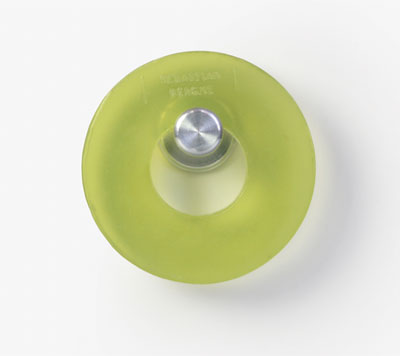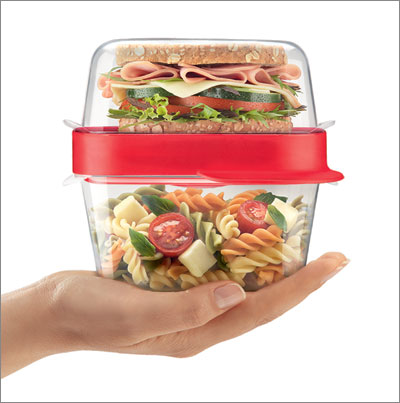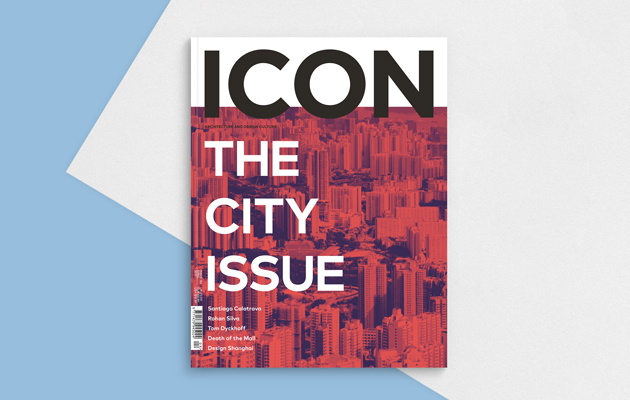|
|
||
|
We spoke to Kingston University’s new head of product and furniture design Sebastian Bergne last year as he celebrated 25 years of his practice The new course director of Kingston University’s product and furniture design MA, Sebastian Bergne celebrated 25 years of his practice in 2016. Although Bergne is probably best known for his witty home accessories and his work with glass, he has designed everything from modular extending shelving to low-key pots and pans. Icon caught up with him in his London studio last year to find out how his practice has changed, and how it might keep on changing.
Ring Soap, initially produced back in 1994, now being reissued by Bergne himself ICON You celebrated 25 years in practice last year by staging an exhibition in your studio during London Design Festival. What did you show? SEBASTIAN BERGNE The exhibition focuses on 25 self-produced pieces. I started doing this kind of work out of necessity because I didn’t have any other clients, much like young designers today. I enjoyed working in this way and have kept going over the years. ICON Are there any designs that started life as a self-produced limited edition, but later got picked up by a manufacturer? SB There was Lampshade, which started out as a self-produced sheet of bent metal. It was picked up by a German company and did quite well commercially. It was my first equivalent of a big hit single. The reverse has happened with the Ring Soap. I designed a soap ring that you could hang on a little peg – it went into production for a couple of years, until it stopped and now I’ve picked up the production myself. I think it’s a great product and it’s always a shame when good ideas are lost or wasted. Also, earning the most out of the ideas that you’ve had as a designer is important, because, in my opinion, designers are undervalued. But I guess that’s a topic for another conversation.
Egg Decanter (2014), hand-blown in borosilicate glass with cork or brick-red rubber details ICON The exhibition focused on your limited editions. Do you have different relationships with your more personal statement pieces and with the more anonymous design? SB I was trained as an industrial designer and graduated from the Royal College of Art in 1990, and it was very much an anonymous profession. For a long time I felt I hadn’t achieved anything in my profession since I hadn’t worked in that way. About ten years ago, I started working for companies like Moulinex or Tefal, and finally did what I was trained to do, with anonymous products made in millions – sadly not on a royalty basis. But I really enjoy doing both. One feeds off the other, and one finances the other, to be honest. ICON Are you worried that the lack of attention given to more traditional, industrial design will mean that young designers won’t want to work in this way? SB If you want to earn a living and have a job at the factory mass-producing consumer products, you can still do it. People forget that, because it’s not in magazines, but that is still 90 per cent of design that happens on the planet. Magazines write a lot about the other stuff made by smaller companies, or individuals, because it’s more newsworthy at the moment, but actually if you walk around the city and see what comes out of factories and what people buy, it’s still mostly that kind of work and it’s still the core profession of design.
Master Seal food container for Tefal (2016) ICON Do you find that audiences today have shorter attention spans and are less willing to read and to engage, perhaps because of the pervasive influence of the internet? SB It’s true in one sense, but there’s still a market for people who think a lot, particularly in the print world. In a supermarket context, people will buy something for different reasons than when they are buying something online from a small-scale manufacturer. Take Tefal: it’s about price, it’s about quality, it’s about being discreet and familiar, and there is a certain amount of design. But you buy it because you need a solid frying pan that will last and will be safe. If you buy design online, you’re buying it for different purposes, perhaps for a novel form, or a manufacturing concept, and you’ll show it to your friends when they come around. On an online platform, people buy images as much as functionality, and you need to assume what you’re getting will work – you don’t want to be too challenging with the function. There is, however, much more image-awareness: photography has become really important. Many designs are quite minimal, and it’s only by accessorising them and putting them in a context that you tell people what they actually are. Some products might not even exist until someone has ordered them, so you’re selling people a dream of what they might have, and the whole cycle of manufacturing, the whole machine, only starts producing it afterwards. It’s an amazing trust that people now have. I am always amazed what people will buy in our online shop. ICON You did a 3D-printed candleholder for online retailer Othr. How did you get involved with them? SB Joe Doucet is one of the founders and he contacted me about a year ago. The manufacturing process is triggered once a product has been ordered, even if it’s the middle of the night. There was a surprising amount of learning involved: people often think that with 3D printing you can make anything, but in the end it is like any other manufacturing process, you need to learn what you can and can’t do. There is a new set of limitations to learn about.
Cubit beer glass (2016) developed in association with the Centre International d’Art Verrier in Meisenthal ICON What can you tell us about your newest product? SB There are actually two new products. One, this jug, I designed here, it’s a bit unusual but nice to handle, it’s very practical, it has a lid that becomes a trivet. It’s an everyday water jug but it has a bit of intelligence. The beer glass came about in a different way, because I was visiting the place where it’s made, a workshop in France, where they have a huge library of moulds. I came across an old mould for a bottle. So I asked one of the blokes at the centre if we could make something with it, and that’s how the Cubit glass was born. At the same time I noticed in the local bar that people had a tradition of adding a bitter liqueur at the bottom of the glass and topping it up with beer, so this glass has a space in the stem for measuring out a shot. It also has an interesting square shape, and this came out of an improvised process in a workshop rather than a studio. ICON So you try to work as widely as possible in terms of manufacture or distribution, but also in terms of process? SB In recent years, people have become very interested in design process. It often implies you should have a set process and following a set process to arrive at a solution implies a level of automation, which I don’t like. I don’t talk a lot about process. I show finished objects, which do have a story to tell, but for me the end product needs to exist on its own. And if it doesn’t have validity as an object, justifying it by the way of a story or a process won’t work. Some ideas come to me in a shower, a kind of eureka moment, while some take forever – two years and a million versions. So I don’t like the idea of following a process or talking about it to give value to what I’m doing.
Plane Shelving steel storage system for Teebooks (2015) ICON Do you think designers today are willing to embrace wit in their work? SB I can talk seriously about all my designs, but life is short, so if there is a witty part to a project, why not? There’s a room for that kind of thing, but it’s not for everyone. There was a time when it was done badly and it started to put people, myself included, off that approach. Done sensitively it can work, but you can’t make everyone happy all the time.
The Egg Decanter balances on its rubber base in a variety of positions |
Words Peter Smisek
Illustration David Sparshott |
|
|
||



























